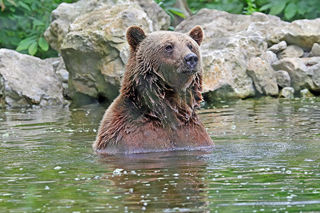
European Brown Bear
Ursus arctos arctos
Brown bears are powerful with short, thick limbs, a big, heavily built body and a distinct shoulder hump, which is due to the large muscles needed for digging up roots and defending territory. Their long claws are specially adapted for digging and can measure up to 10cm.
Behaviour
Undergo a winter torpor, relying on fat reserves that they have built up over the summer period in order to see them through the winter months. Hibernation dens are usually caves.
Mostly solitary, but will gather in large numbers at important food sources, therefore there is a social hierarchy based on age and size (adult male bears being at the top). Females raise cubs on their own, having given birth during the winter hibernation period.
UK Status
Bears have a long history in the UK, however evidence of them in the fossil record stops around the end of the medieval period (1066 onwards). After this, bear remains are only found in London probably due to bear baiting arenas.
Threats
Historically, bears have been used for entertainment purposes (bear baiting and bear dancing) and sadly this still occurs throughout the world. Bears are opportunistic feeders and are attracted to high human density areas to take advantage of our food sources; this leads to direct conflict.
Poaching (for gall bladders and paws) and canned hunting are big problems for most European brown bears. Habitat loss, persecution and accidental mortality are all threats for the European populations of brown bears.

Distribution
Most widely distributed bear. Historically, they were once native to much of Asia, northern Africa, Europe and North America, however today, numbers have become greatly reduced, even becoming extinct in some areas.
Habitat
They occupy a huge range of habitat types, from temperate rainforests, arctic scrublands, and coastal areas even to dry desert edges. This is thought to enable them to exploit a wide variety of food items seasonally.
Diet
Extremely varied omnivorous diet (meat and vegetation) which changes drastically through the seasons. Up to 75% of diet is made up of plant material (such as fruit, nuts, and acorns). Their daily calorific intake during summer and autumn can reach up to 20,000 calories in order to put enough weight on to safely see them through their winter torpor.
Wildwood inside information
We are home to two adult bears called Fluff and Scruff and one younger bear called Boki. Fluff and Scruff arrived in November 2014 after being rescued from a shocking life in Bulgaria. They were born at a breeding centre, bred to be hunted. Before coming to Wildwood they lived their entire lives in small, barren, concrete pits. Their rescue was possible due to Wildwood’s fantastic supporters who helped raise funds. Now they live in a spacious woodland home with inside denning areas. Boki joined us in December 2022 after being rejected by his family. He made UK news when he underwent a brain scan and subsequent surgery for hydrocephalus.
Our aim is to give them the most natural life possible, and a chance to express natural behaviours. Every year, during Winter, our bears enter torpor (a form of semi hibernation), a crucial natural behaviour. Although you won't get to see them during Winter, you may be lucky enough to see them on the big screen, installed CCTV to keep an eye on them.
Family facts
Fluff is the bigger bear out of the two and the most dominant. Scruff doesn’t sleep as deeply as Fluff and during their torpor period, takes advantage of Fluff’s doziness by readily instigating the wrestling!
Brown Bears can pack on a massive 180kg of fat during the autumn in order to get them through the winter.
Male Brown bears can be at least 30% larger than females.





